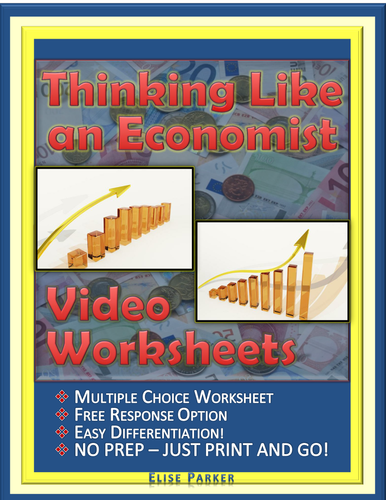
Make economics come to life with these 25 questions that guide students through Episode 1 of "Thinking Like an Economist," a 12-part video series from the Great Courses
Thinking Like an Economist helps make economics concepts crystal clear to a high school audience by providing students with real-world anecdotes and examples that perfectly illustrate key concepts and bring them fully to life. Using resources as diverse as bumper sticker slogans and the rules of wrestling, Professor Randall Bartlett shows how economic concepts surround us all the time. Once students have seen a few episodes of this fantastic series, they'll achieve the promise of the title and start thinking like economists themselves!
ABOUT THESE THINKING LIKE AN ECONOMIST WORKSHEETS
Each episode lasts 30 minutes, and even though they're very interesting, some students may have trouble paying sustained attention. That's where these worksheets come in. You can use them to hold students accountable either during viewing or afterwards as a quiz.
DIFFERENTIATION AT YOUR FINGERTIPS
Teachers need options, and this worksheet set gives you an important one: All questions are provided in either multiple choice or free response format.
CONVENIENCE FEATURES IN THIS THINKING LIKE AN ECONOMIST WORKSHEET SET
--- All questions are in video order so that students can easily follow along, using the worksheets during viewing.
--- Fast-correct answer keys are provided for both the multiple choice and free response versions of the questions.
--- Full context answer keys are also provided for both, giving teachers questions and answers on the same page. These are helpful for guiding discussions and going over answers together with the class.
ABOUT EPISODE 1 OF THINKING LIKE AN ECONOMIST
This episode provides students with six key concepts that will help them understand their world a lot better, as seen through the lens of economics. These include:
--- People respond to incentives.
--- Every transaction has at least two sides.
--- Expect unintended consequences.
--- There are always unanticipated influences.
--- Nobody is in control.
Episode 1 develops the theme that will echo throughout the entire series: Rational decision-making in a complex, interrelated world. Key concepts discussed in detail in Episode 1 include ideas found in the first chapter of most Econ textbooks: scarcity, opportunity costs, incentives, and more!
Thinking Like an Economist helps make economics concepts crystal clear to a high school audience by providing students with real-world anecdotes and examples that perfectly illustrate key concepts and bring them fully to life. Using resources as diverse as bumper sticker slogans and the rules of wrestling, Professor Randall Bartlett shows how economic concepts surround us all the time. Once students have seen a few episodes of this fantastic series, they'll achieve the promise of the title and start thinking like economists themselves!
ABOUT THESE THINKING LIKE AN ECONOMIST WORKSHEETS
Each episode lasts 30 minutes, and even though they're very interesting, some students may have trouble paying sustained attention. That's where these worksheets come in. You can use them to hold students accountable either during viewing or afterwards as a quiz.
DIFFERENTIATION AT YOUR FINGERTIPS
Teachers need options, and this worksheet set gives you an important one: All questions are provided in either multiple choice or free response format.
CONVENIENCE FEATURES IN THIS THINKING LIKE AN ECONOMIST WORKSHEET SET
--- All questions are in video order so that students can easily follow along, using the worksheets during viewing.
--- Fast-correct answer keys are provided for both the multiple choice and free response versions of the questions.
--- Full context answer keys are also provided for both, giving teachers questions and answers on the same page. These are helpful for guiding discussions and going over answers together with the class.
ABOUT EPISODE 1 OF THINKING LIKE AN ECONOMIST
This episode provides students with six key concepts that will help them understand their world a lot better, as seen through the lens of economics. These include:
--- People respond to incentives.
--- Every transaction has at least two sides.
--- Expect unintended consequences.
--- There are always unanticipated influences.
--- Nobody is in control.
Episode 1 develops the theme that will echo throughout the entire series: Rational decision-making in a complex, interrelated world. Key concepts discussed in detail in Episode 1 include ideas found in the first chapter of most Econ textbooks: scarcity, opportunity costs, incentives, and more!
Something went wrong, please try again later.
This resource hasn't been reviewed yet
To ensure quality for our reviews, only customers who have purchased this resource can review it
Report this resourceto let us know if it violates our terms and conditions.
Our customer service team will review your report and will be in touch.
$2.00
